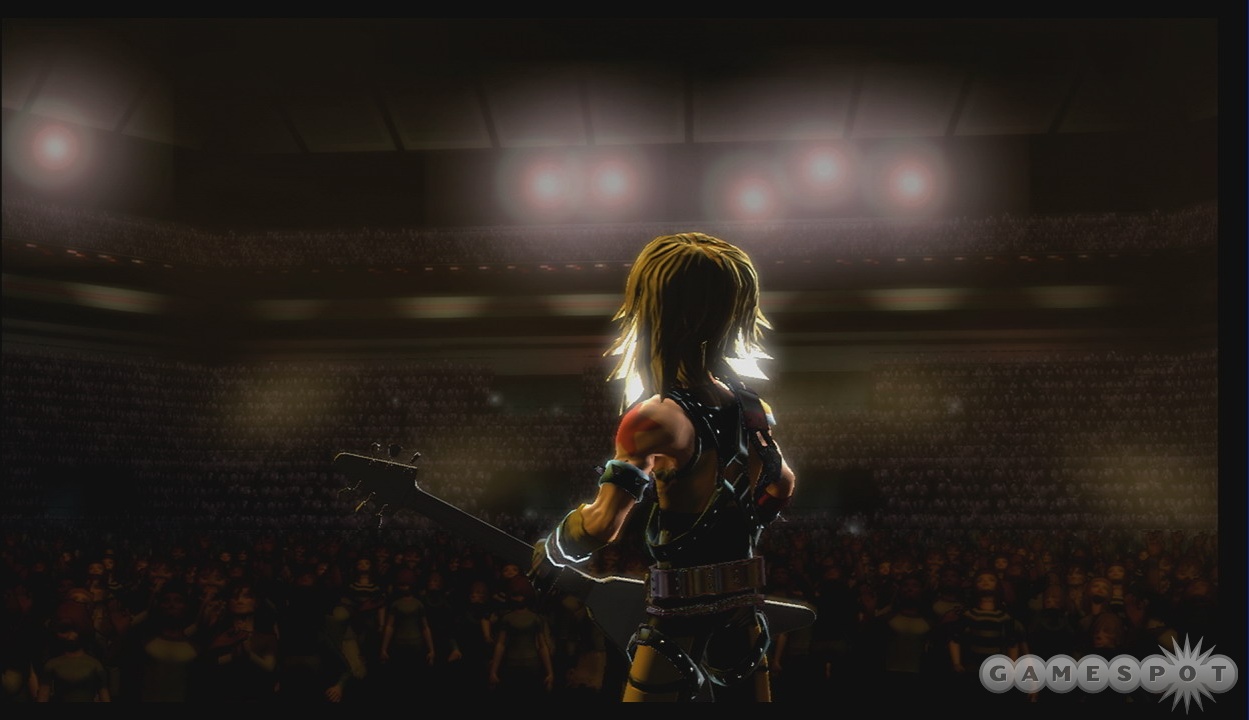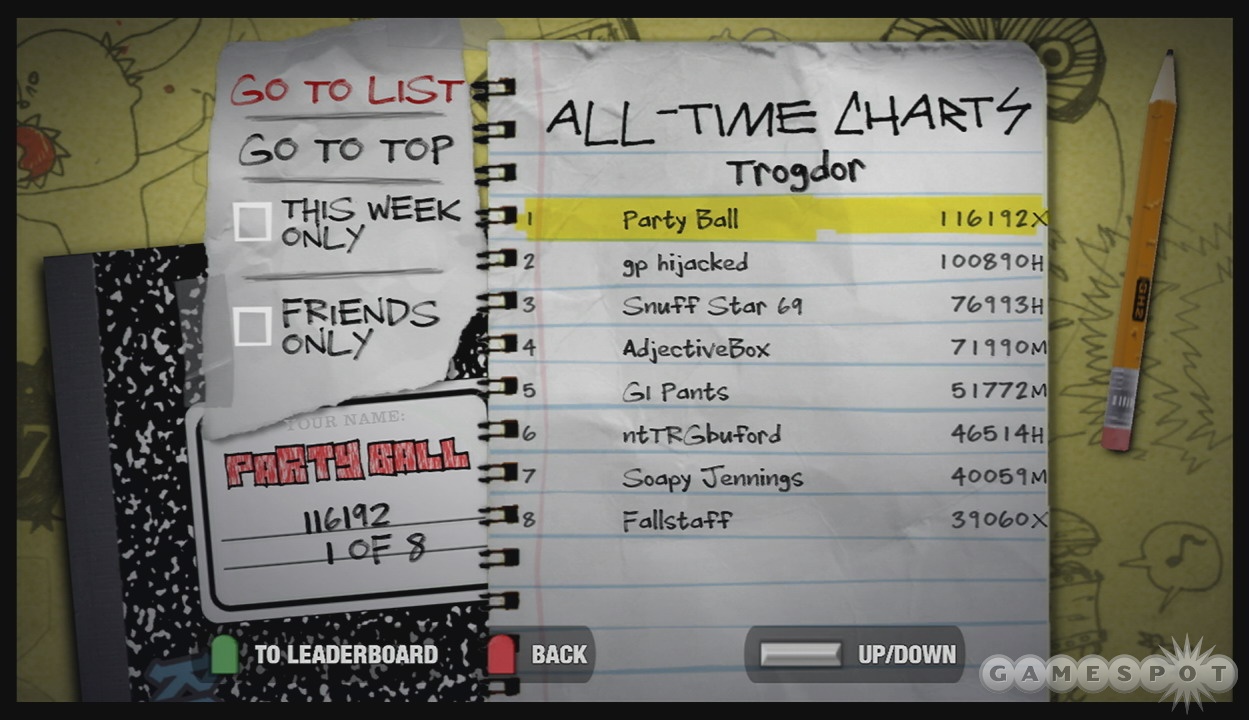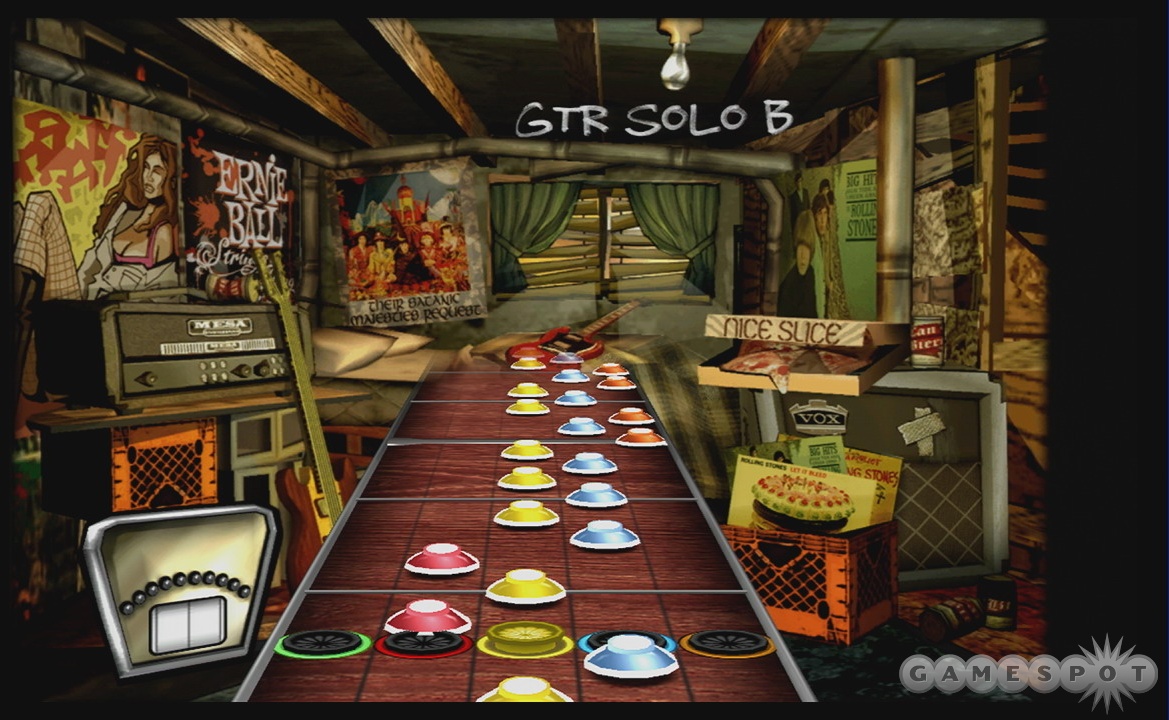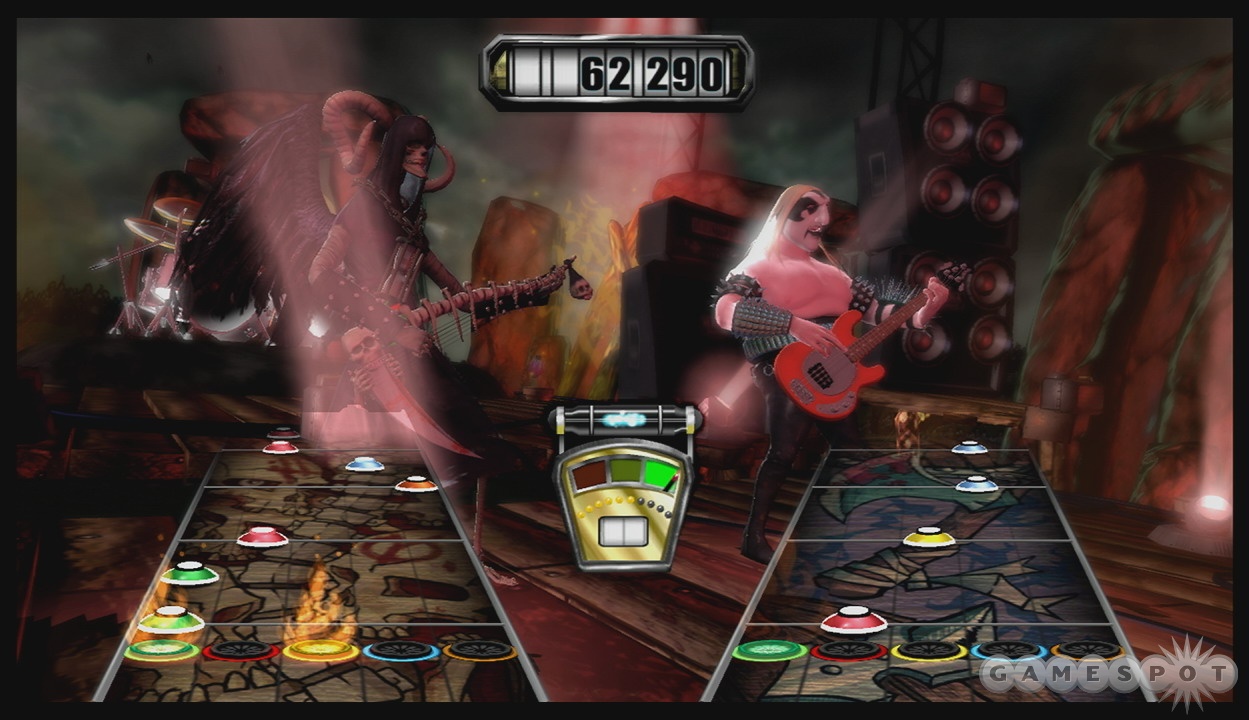If you're an Xbox 360 owner, a lover of rock music, and someone with close to $100 burning a hole in your pocket, your day has finally come. RedOctane's once PlayStation 2-exclusive Guitar Hero series has come to the 360 in Guitar Hero II. As you would expect, this is primarily a port of the PS2 version released last year, with all the same hard-rocking tracks and play modes. But the 360 version adds a significant chunk of content, with additional songs, online leaderboards, and the promise of downloadable content. Longtime Guitar Hero fans might be a bit wary of spending another big chunk of change for a new guitar and an updated version of a game they probably already own, and that's fully understandable. But for 360 owners that haven't already invested heavily in this series and have the unquenchable desire to get their rock on, Guitar Hero II is absolutely a must-own.

For those who aren't intimately familiar with the Guitar Hero series, here's a quick primer on how it plays. The guitar controller features a strumming button, as well as five color-coded fret buttons on the neck of the guitar. Onscreen, notes color coded the same way as the fret buttons travel down the screen, and you need get your fingers on the correct fret buttons while strumming in time with the notes. Each hit note scores you points, and creating lengthy combos ups a score multiplier. Your progress is tracked by a "rock meter," and if you miss too many notes, you'll eventually hit the red and fail the song. Furthermore, every now and again you'll gain "star power" by perfectly hitting a section of notes. This star power feeds into a meter, and by tilting the guitar at an opportune time, star power will deploy, giving you twice as many points per note as you'd normally get. Oh, and there's a whammy bar.
That's a fairly technical explanation of what basically boils down to hitting the notes and making with the rock. In the case of the Xbox 360 version, you'll be doing this using a different tool than the PS2 version. The guitar controller is fashioned after the Gibson X-Plorer brand of guitar, which features a more striking body design than the standard SG model the PS2 game used. Longtime Guitar Hero fans might not love the change to the way the guitar strap sits. It hooks into the back of the neck, as opposed to the body of the guitar, which occasionally leads to the strap getting twisted, making it uncomfortable to play. This one quibble aside, the X-Plorer is a much more solid-feeling controller than the SG model. The buttons are raised slightly higher off the neck, and they, as well as the strummer, don't clack as much or as loudly as the PS2-model controller. You might also run into some awkwardness if you like to hit the select button to deploy star power. But frankly, you should be tilting the guitar anyway. It's all about showmanship, after all.
As mechanically excellent as the Guitar Hero series has been up to this point, the truth is that much of its appeal comes from the song selection. The first Guitar Hero nailed the song list almost perfectly, primarily focusing on memorable rock riffs that any armchair shredder would be stoked to play. Guitar Hero II went a bit more obscure with its soundtrack, changing the focus from classic riffs to insane solos and reckless acts of guitar wankery. Not a bad choice, mind you--just a different one. Of course, there are plenty of major artists to be found in this game. Just to name a few, songs by Aerosmith, Cheap Trick, the Rolling Stones, Nirvana, Guns 'N Roses, Rage Against the Machine, The Police, Megadeth, and Lynyrd Skynyrd all make an appearance. But wait, there's more! The 360 version adds 10 new songs to the mix, including tracks like Iron Maiden's "The Trooper," Rancid's "Salvation," Pearl Jam's "Life Wasted," and, in the most inspired of selections, Rick Derringer's "Rock and Roll Hoochie Coo." This brings the overall song total to 74, with 48 of those being licensed tracks from major artists and the remainder coming from smaller independent bands.
While the song list might be bigger, there are definitely a number of included tracks that aren't necessarily stand-outs. There are some legitimate classics here to be sure, like every metal head's favorite love song, "Sweet Child O' Mine," or the Southern rock anthem "Free Bird." But if you're going to get Aerosmith in your game, why would you pick a song like "Last Child" over any of their numerous bigger, just as solo-heavy hits? And is "You Really Got Me" really the best Van Halen song that could be dug up? Of course, even the oddball choices are usually still quite fun to play, and there are a number of fantastically fun songs that you probably never would have thought of on your own, like The Pretenders' "Tattooed Love Boys" or The Police's "Message in a Bottle." You also probably won't be able to shake the feeling that you'd rather be playing just about any other Van Halen song, though.

Save for a couple of original master tracks (Primus' "John the Fisherman" and Jane's Addiction's "Stop" from the original crop, as well as My Chemical Romance's "Dead!" and Toadies' "Possum Kingdom" of the 360-exclusive tracks), all the major licensed tracks are covers, played by studio musicians. Some of the covers in the game are legitimately tough to pick out, such as the fantastically produced "Carry on Wayward Son" by Kansas and "Woman" by Wolfmother. Others are a bit more scattershot in quality. Some of the vocalists in particular don't come off much like the real-life singers. The fake Ozzy Osbourne and Dave Mustaine in GH II aren't quite spot-on (which is odd, since the first Guitar Hero game had near-perfect soundalikes for both vocalists), and the guy portraying Zach De La Rocha in Rage Against the Machine's "Killing in the Name" comes off like an awful rap-rock karaoke performance. Still, these less-than-stellar examples are more aberrations than the norm, and the vast bulk of the songs are excellent renditions, especially in the guitar parts; and in a game about playing the guitar, ultimately that matters most.
Apart from the added songs and new controller, other 360-exclusive additions to the game include online leaderboards and downloadable content. The leaderboards are pretty self-explanatory, and they track your high scores across every single song in the game, and there's also an overall career score that combines all your scores into one gigantic number. You can filter the career score to include only the career mode or factor in high scores from other modes as well. Considering that Guitar Hero is, by nature, a highly competitive game, the addition of leaderboards is a huge boon to the game. Now you can finally show all your online buddies just how much you stink at "Psychobilly Freakout." The downloadable content isn't currently up for download, but we do know that the bulk of the new content is going to be added songs. Pricing isn't set at this moment, so things could potentially get expensive. Still, having the option to add even more songs over time is pretty awesome.
The holdover modes from Guitar Hero II have gone mostly unchanged, but are still excellent in their own right. The PS2 version of Guitar Hero II saw the debut of the practice mode, which was a highly welcome addition, especially considering the occasionally overwrought difficulty level of the harder tracks. Since you aren't able to play through songs in quickplay or the career mode without being tied to the rock meter (and potentially failing before you get to the end), the new practice mode lets you play through any of the songs without fear of failure. What's more, you can play any specific section of a song you want, at the speed you want. Songs are broken down piece by piece, and you can pick any starting and stopping section you please. When you complete songs in the quickplay or career modes, you can access detailed stats that depict exactly how well you did on each individual section, so it's not tough to figure out where you need to improve. Three slower speeds are included, letting you slow a solo to a crawl so you can identify just how crazy that solo is.

It's an incredibly useful tool for figuring out ways to best some of the game's peskier parts, and it's very easy to use. There's even an option to jump right into practice mode from the options menu that pops up when you fail a song in one of the other modes. Unfortunately, this mode doesn't show star-power sections, nor does it give any indication of how close you might be to failing a song. Not letting you fail is good, but some kind of indication to see just how badly you're screwing up would have been nice. And being able to figure out where best to use star power would also have been good, since often you can only survive some of these crazy solos with well-placed star-power usage. The mode also lacks any sort of loop feature, meaning each time you complete a section, you'll have to reload it to play again.
Career mode is where you'll spend much of your time initially as you work to unlock the game's many songs. The career progression works much the same as it always has, with four sections broken up by difficulty. One thing that has changed in the 360 version is the track order. While having a different order to the set list might not sound like a huge deal, it improves the flow of the career mode significantly, as the difficulty balance is much, much better. In the PS2 version, there were some songs that felt totally out of whack where they were, and here the tweaks pretty much eliminate that feeling, save for a few rare instances ("YYZ" is still way too easy to come as late as it does). As you play through the career, you'll unlock a bunch of new songs, as well as earn cash to spend in the game's store. New characters, costumes, guitars, guitar finishes, and yes, even songs can be purchased here. There are some truly fantastic axes to be unlocked, most of which are licensed Gibson guitars, but a few of which are so comically bizarre that you can't help but love them. Viking guitar, anyone?
Multiplayer includes two forms of competitive play. One has you and a friend trading off sections of a song, and the other has the two of you playing through a whole song the whole time. The other option is cooperative play, and in this mode, only one of you can play lead guitar. The other player gets to pick up the rhythm guitar, or bass, depending on the song. When playing lead and rhythm guitar together, the game splits up the guitar parts you've been playing in the single-player in such a way that you realize you've often been playing two guitar pieces mashed into one all along. There are times when rhythm sections are actually more challenging than the lead sections, though they're also decidedly lacking in solo action, for the most part. The split between guitar and bass is more pronounced. Bass is, after all, a more repetitive instrument, and some of the bass parts in the game are flat-out boring. But a good number of them are also extremely fun, especially in any song where the bass is a more pronounced instrument within a band, such as Primus or Rush. Perhaps the scattered level of quality of the secondary parts is why these aren't available for play anywhere else in the game besides here and practice mode. Still, you could easily argue that in a band like Primus, the bass is practically the lead instrument, and not being able to play the bass in even quickplay is a bit disappointing.
What's weird about the cooperative mode itself is that you don't always get the sense that you're playing with someone, so much as playing next to another person. Obviously, the different instruments play into each other within the song, but there's something slightly mechanical about the way the two instruments play together in this mode. This is less a problem with rhythm guitar tracks and mostly an issue in bass songs that aren't crazy in the way that the Rush or Primus songs are. Basically, it's frequently hard to hear the bass guitar, even with the bass audio cranked up as much as it is, so it's tough to gauge how much effect you're really having on the song when playing bass. Seemingly, the developers realized this and tried to give the mode a bit more oomph by tying both players into a single rock meter and combo multiplier. So if your friend is really tanking on their part, you'll both lose your combo buildup and potentially fail the song. You even engage star power by both tilting your guitars. While that could be potentially disastrous if you're playing with a less-experienced player, the game mercifully lets you select individual difficulty levels for each part in this mode.
As you would expect from any 360 game, Guitar Hero II on the 360 tosses achievements into the mix. There are 50 achievements, and the difficulty of them covers both ends of the spectrum. There are some jokingly easy achievements, such as the points you earn for failing a song on easy or refusing to do an encore in the career mode. Then there are such gems as the "Yngwie Malmsteen" achievement for getting a 1,000-note streak on a single song (if you don't know who that is, look him up, and you'll get the association), or the achievement for getting 500,000 points in a single song. You'll get a bunch of achievements quickly and then have to work hard to get the rest. It's a nicely balanced list. The only bummer is that the game still doesn't support online multiplayer, meaning you'll need to drag another expert-player friend over to get all the cooperative multiplayer achievements.

Guitar Hero II's graphics aren't exactly the most impressive out there, but the game has an explicitly goofy and decidedly rock-and-roll in-joke visual style to it that just works. From guitarists like Lars Umlaut, a hulking Norwegian death metal guitarist with a fancy for elaborate costumes and breathing fire, to the insanely elaborate stage sets, with tons of flashing lights, pyrotechnics, and big cutouts of the grim ripper fighting a giant octopus monster, among other things, you can't be a rock fan and not chuckle at how totally bananas the game's look is. Granted, most times your eyes will be squarely focused on the fret board and the notes flying at you, but even if you're just catching it in the periphery, it's great to see. The 360 version of Guitar Hero II doesn't do a ton to improve the overall look of the game. It runs in HD now, so some of the details of the guitarists and sets are more discernable. Everything also looks crisper and brighter than it ever did on the PS2, even if you're running in SD. You can't quite call it a great-looking 360 game, but the graphics more than get the job done.
That 360 owners can now see what PS2 owners have been enjoying so much over the last couple of years with the Guitar Hero series, and do it with even more added content, is a fantastic thing. The track list is gigantic, the multiplayer is a great deal of fun, the practice mode is a godsend, and the downloadable content is sure to give this game a long shelf life. If you've never had the opportunity to try Guitar Hero before, this is the definitive way to do it. PS2 owners might be reluctant to drop nearly another $100 on a game they've already played a bunch, but there's an investment-like quality to this game. Guitar Hero isn't going to be coming to the PS2 forever, and with the series starting off with such a bang on the Xbox 360, it might just make investing in Guitar Hero II again worth your while.